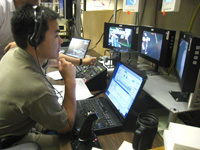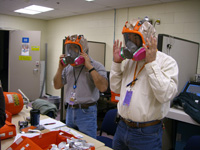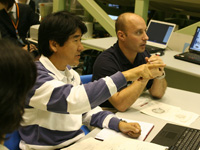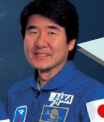JAXA Astronaut Activity Report, October 2007
Last Updated: December 20, 2007
This is JAXA's Japanese astronaut primary activity report for October 2007.
Kibo mission-specific training
Astronauts Doi (1J/A STS-123 Mission), Hoshide (1J STS-124 Mission), Wakata and Noguchi (ISS Expedition 18) participated in their respective mission-specific training sessions at JAXA Tsukuba Space Center (TKSC). The sessions included training on assembling the Japanese Experiment Module, Kibo, during the 1J/A (STS-123) Mission, the 1J (STS-124) Mission, and the ISS Expedition 18 mission.
Astronaut Furukawa, assigned as a Crew Support Astronaut for ISS Expedition 18, and astronaut Yamazaki, assigned as a Crew Support Astronaut for astronaut Doi during the STS-123 shuttle mission, also participated in the training sessions.
For astronauts Doi and Hoshide, these training sessions were the last Kibo training sessions to be conducted at TKSC before their respective space shuttle flights.
Crew Equipment Interface Test (CEIT) for Kibo

Astronaut Doi (left) and the 1J/A crew members examining the 1J/A mission-related equipment.
At NASA Kennedy Space Center (KSC), the 1J/A Mission (STS-123) crew members, including astronaut Doi, along with NASA astronaut Garrett Reisman (right) who will be launched with the STS-123 crew and then will remain on orbit as part of the International Space Station (ISS) Expedition 16 crew, conducted a Crew Equipment Interface Test (CEIT) for Kibo.
During a CEIT, the assigned crew members have the opportunity to familiarize themselves with and verify the flight readiness of the equipment that they will actually use during their mission.
During the CEIT, the astronauts reviewed the procedures for removing the Multi-Layer Insulation (MLI) covers from the Common Berthing Mechanism (CBM) and the seal covers that protect the CBM from contamination. These items will be handled by the Extravehicular Activity (EVA) crew during an EVA prior to connecting Kibo’s ELM-PS to the Harmony module. The astronauts also checked the MLI covers for trunnion pins. The trunnion pins are locking devices that will be used to secure the ELM-PS in the space shuttle’s payload bay during launch. In addition, the crew reviewed the procedures for removing a tool bag that will be attached to the front of one of Kibo’s system racks prior to reconfiguring the rack. The crew also verified the accessibility to a cable connector that will supply power from the space shuttle to Kibo’s ELM-PS.
Using a Virtual Reality (VR) system for Robotic Arm Simulation Training

Astronaut Hoshide using the Virtual Reality system simulator
At NASA Johnson Space Center (JSC), astronaut Hoshide, along with his 1J crew members, participated in training on tasks that will require coordinating operations between the EVA crew and the robotic arm operators during EVAs that are scheduled for the 1J Mission. Astronaut Yamazaki, who is currently assigned to the Astronaut Office Robotics Branch at NASA, also participated in the training.
During the 1J Mission, astronaut Hoshide will operate the ISS robotic arm, Canadarm2, for robotic operations that include attaching Kibo’s Pressurized Module (PM) to the Harmony (Node 2) connecting module. Astronaut Hoshide will be the first JAXA astronaut to operate the Canadarm2.
During the training session, the robotic arm operators, including astronaut Hoshide, simulated the tasks that will require coordinated activities with the EVA astronauts, including the removal of the Orbiter Boom Sensor System (OBSS) from the OBSS Boom Stand installed on the ISS S1 truss. The crew members verified each procedure.
ISS Emergency Procedure Training

Astronauts Wakata (left) and Noguchi (right) wearing gas masks
Astronauts Wakata and Noguchi participated in ISS emergency procedure training at NASA Johnson Space Center (JSC). This session of the ISS Exhibition 18 training covered the procedures for responding to emergencies that may occur at the ISS, including ammonia coolant leaks, fire, and sudden air decompression.
During the training session, the astronauts received instructions on the procedures for responding to emergencies, including using the IVA Ammonia Detection Kit, donning gas masks, and locating other astronauts.





